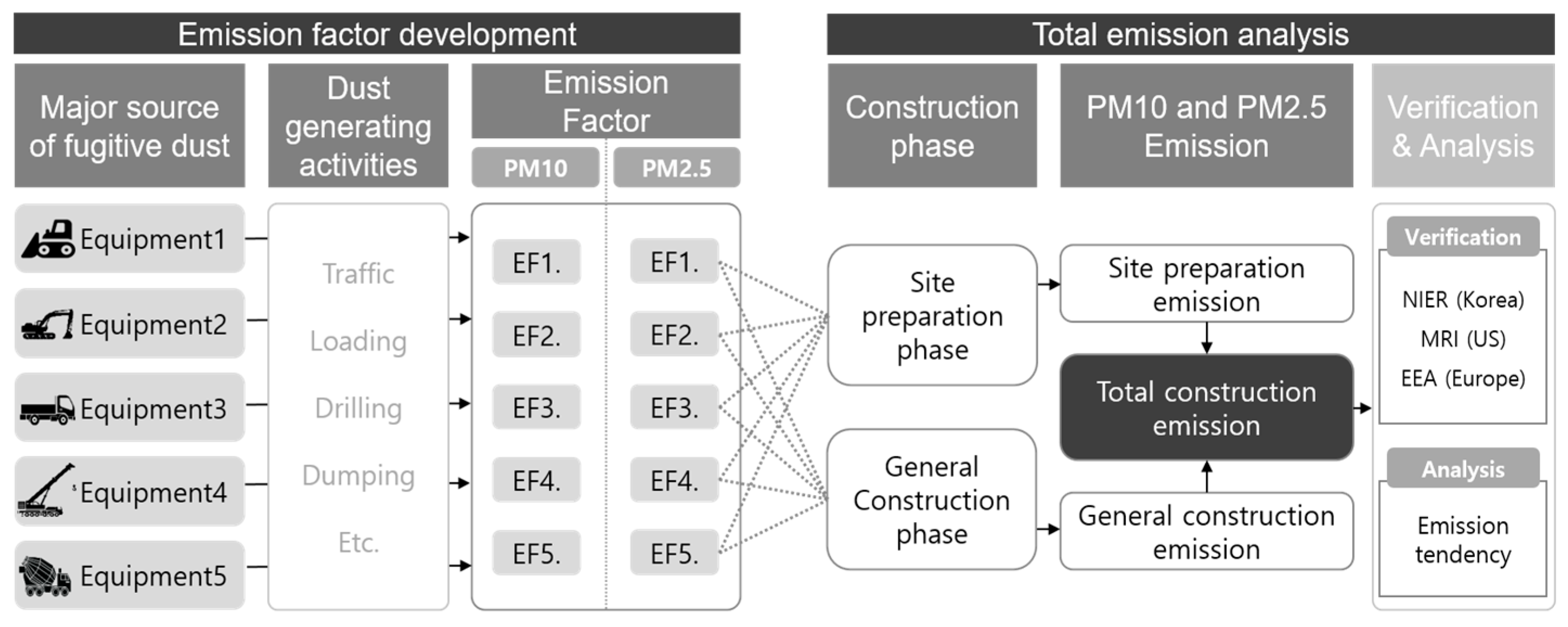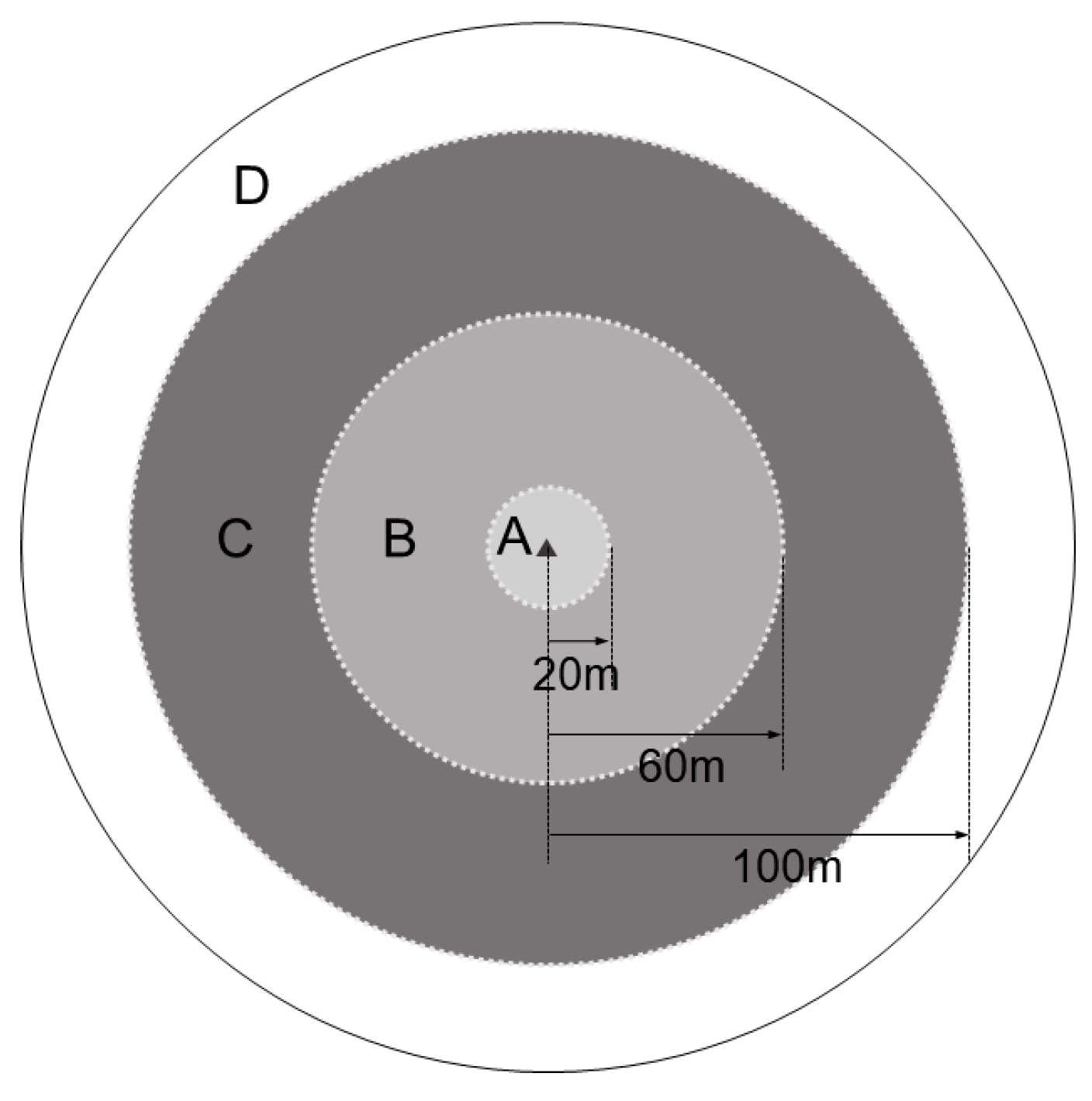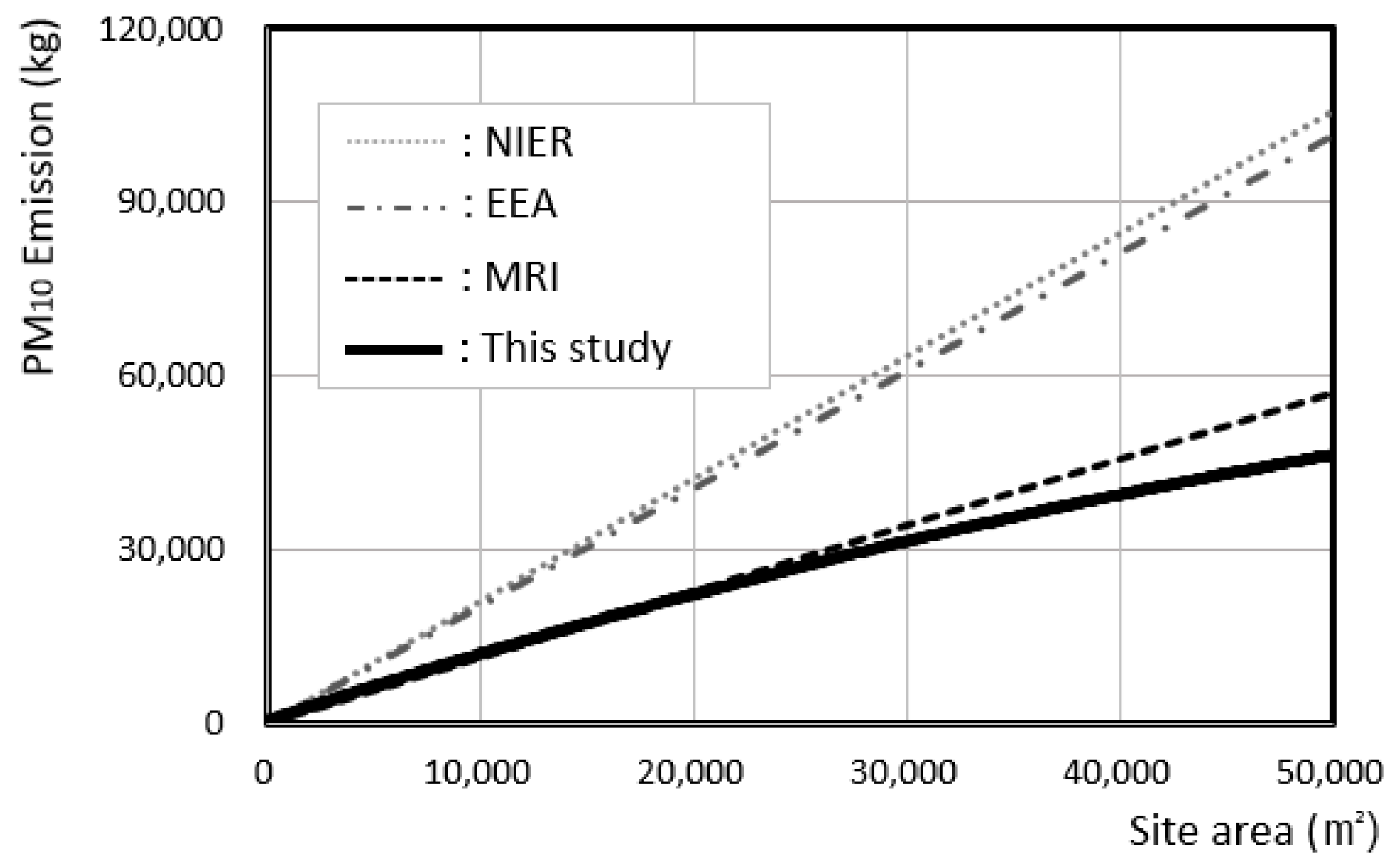Calculation Methods of Emission Factors and Emissions of Fugitive Particulate Matter in South Korean Construction Sites
Abstract
1. Introduction
2. Materials and Methods
2.1. Emission Factor Development
2.1.1. Major Dust-Generating Equipment and Construction Site Activities
2.1.2. Emission Factor
2.2. Particulate Matter Emission
2.2.1. Dust-Generating Activities
2.2.2. Workload Allocation by Equipment for Emission Calculation
2.2.3. Emission Calculation
3. Result
3.1. Emission Factor (EF)
3.2. Emissions (E)
3.3. Results and Trend Analysis
3.4. Emission Amount Trend Analysis According to the Major Emission Factor Variables
4. Discussion
5. Conclusions
- The South Korean emission factors of PM10 and PM2.5, according to the generation of fugitive dust for 10 types of construction equipment and activity due to the workload and travel speed of construction equipment, were derived using the methods presented in EPA AP-42.
- In addition, methods to calculate the amount of PM10 and PM2.5 generated due to fugitive dust in construction sites by including information about the site area, earth volume, and the amount of construction materials using the derived emission factors were presented, and the results obtained using these methods were analyzed.
- Analysis from the perspective of construction site area and construction phases showed that the ratio of PM emission generated in the general construction phase increases compared to the earthwork phase when site area increases. However, the absolute amount of PM generated in the earthwork phase was found to be significantly higher than the amount generated in the general construction phase. This information indicated that nearby residents and on-site workers were exposed to the greatest amount of PM during earthwork.
- Of emission equations developed in the US, Europe, and South Korea, emissions by the area of the construction site were most accurate when derived by the MRI equation of the US. However, unlike the existing equations that showed a linear increase in emissions with an increase in the area, the results of this study showed a decrease in emissions per unit area when site area increased.
- Emission trend analysis according to silt and moisture content, which are major variables of fugitive dust, showed that emissions decreased in the form of a power curve with an increase in the moisture content. The change was minimal if the moisture content was higher than 40%, while PM emissions increased with an increase in silt content.
- The findings of this study are expected to be used as basic data for setting reasonable emissions standards for PM at construction sites in South Korea through comparisons with the results of case studies in real construction sites. Additionally, the importance of establishing the emission standards and appropriate emission factors are discussed. The results present guidelines for PM emission management at construction sites and to establish integrated PM emission management systems for construction sites.
Author Contributions
Funding
Conflicts of Interest
References
- Yoo, S.-Y.; Kim, T.; Ham, S.; Choi, S.; Park, C.-R. Importance of urban green at reduction of particulate matters in Sihwa Industrial Complex, Korea. Sustainability 2020, 12, 7647. [Google Scholar] [CrossRef]
- Ohara, T.; Akimoto, H.; Kurokawa, J.; Horii, N.; Yamaji, K.; Yan, X.; Hayasaka, T. An Asian emission inventory of anthropogenic emission sources for the period 1980–2020. Atmos. Chem. Phys. 2007, 7. [Google Scholar] [CrossRef]
- Zhang, Q.; Streets, D.G.; Carmichael, G.R.; Huo, H.; Kannari, A.; Klimont, Z.; Park, I.; Reddy, S.; Fu, J.S.; Chen, D.; et al. Asian emissions in 2006 for the NASA INTEX-B mission. Atmos. Chem. Phys. 2009, 9, 4081–4139. [Google Scholar] [CrossRef]
- Guo, S.; Hu, M.; Zamora, M.L.; Peng, J.; Shang, D.; Zheng, J.; Du, Z.; Wu, Z.; Shao, M.; Zeng, L. Elucidating severe urban haze formation in China. Proc. Natl. Acad. Sci. USA 2014, 111, 17373–17378. [Google Scholar] [CrossRef] [PubMed]
- Basile-Doelsch, I.; Meunier, J.D.; Parron, C. Another continental pool in the terrestrial silicon cycle. Nature 2005, 433, 399. [Google Scholar] [CrossRef]
- Sun, Y.; Zhuang, G.; Tang, A.; Wang, Y.; An, Z. Chemical characteristics of PM2.5 and PM10 in haze−fog episodes in Beijing. Environ. Sci. Technol. 2006, 40, 3148–3155. [Google Scholar] [CrossRef] [PubMed]
- Yang, X.; Lu, D.; Tan, J.; Sun, X.; Zhang, Q.; Zhang, L.; Li, Y.; Wang, W.; Liu, Q.; Jiang, G. Two-Dimensional silicon fingerprints reveal dramatic variations in the sources of particulate matter in Beijing during 2013–2017. Environ. Sci. Technol. 2020, 54, 7126–7135. [Google Scholar] [CrossRef] [PubMed]
- Wong, C.-M.; Vichit-Vadakan, N.; Kan, H.; Qian, Z. Public Health and Air Pollution in Asia (PAPA): A multicity study of shortterm effects of air pollution on mortality. Environ. Health Perspect 2008, 116, 1195. [Google Scholar] [CrossRef] [PubMed]
- Health Effects Institute (HEI). Understanding the Health Effects of Ambient Ultrafine Particles; Health Effects Institute: Boston, MA, USA, 2011. [Google Scholar]
- United States Environmental Protection Agency (US EPA). Integrated Science Assessment for Particulate Matter; Center for Public Health & Environment Assessment: Washington, DC, USA, 2019.
- Delfino, R.J.; Quintana, P.J.E.; Floro, J.; Gastañaga, V.M.; Samimi, B.S.; Kleinman, M.T.; Liu, L.J.S.; Bufalino, C.; Wu, C.F.; McLaren, C.E. Association of FEV1 in asthmatic children with personal and microenvironmental exposure to airborne particulate matter. Environ. Health Perspect 2004, 112, 932–941. [Google Scholar] [CrossRef] [PubMed]
- van Donkelaar, A.; Martin, R.V.; Brauer, M.; Boys, B.L. Use of satellite observations for long-term exposure assessment of global concentrations of fine particulate matter. Environ. Health Perspect 2015, 123, 135–143. [Google Scholar] [CrossRef] [PubMed]
- Chowdhury, S.; Dey, S. Cause-specific premature death from ambient PM 2.5 exposure in India: Estimate adjusted for baseline mortality. Environ. Int. 2016, 91, 283–290. [Google Scholar] [CrossRef] [PubMed]
- Han, X.; Liu, Y.; Gao, H.; Ma, J.; Mao, X.; Wang, Y.; Ma, X. Forecasting PM 2.5 induced male lung cancer morbidity in China using satellite retrieved PM 2.5 and spatial analysis. Sci. Total Environ 2017, 607–608, 1009–1017. [Google Scholar] [CrossRef] [PubMed]
- Reff, A.; Bhave, P.V.; Simon, H.; Pace, T.G.; Pouliot, G.A.; Mobley, J.D.; Houyoux, M. Emissions inventory of PM2.5 trace elements across the United States. Environ. Sci. Technol. 2009, 43, 5790–5796. [Google Scholar] [CrossRef] [PubMed]
- The Ministry of Environment (ME). Status of Civil Complaint Related to Fugitive Dust. Available online: http://stat.me.go.kr/ (accessed on 30 July 2020).
- Noh, H.J.; Lee, S.-K.; Yu, J.-H. Identifying Effective Fugitive Dust Control Measures for Construction Projects in Korea. Sustainability 2018, 10, 1206. [Google Scholar] [CrossRef]
- Ministry of Environment. Scattering Dust Management Manual; Ministry of Environment: Sejong, Korea, 2017.
- Midwest Research Institute (MRI). Background Document for Revisions to Fine Fraction Ratios Used for AP-42 Fugitive Emission Factors; Midwest Research Institute: Kansas City, MO, USA, 2006. [Google Scholar]
- European Environmental Agency (EEA). EMEP/EEA Air Pollutant Emission Inventory Guidebook; European Environmental Agency: Copenhagen, Denmark, 2019. [Google Scholar]
- US EPA. AP-42: Compilation of Air Emissions Factors; Chapter 13.2.3 Heavy Construction Operations; Environmental Protection Agency: Washington, DC, USA, 1995.
- National Institute of Environmental Research (NIER). National Air Pollutant Emission Calculation Method Manual III; National Institute of Environmental Research: Incheon, Korea, 2013.
- Gyeonggi Research Institute (GRI). Introduction Plan of Seasonal Management System for Particulate Matter in Gyonggi-do; Gyeonggi Research Institute: Suwon, Korea, 2019. [Google Scholar]
- NIER. Improvement in the Calculation Method of the Amount of Fugitive Dust Emission Amount and the Development of Real-Time Measurement Method of Resuspended Road Dust; Final report; National Institute of Environmental Research: Incheon, Korea, 2008.
- Ministry of Land, Infrastructure and Transport (MOLIT). Standard of Construction Estimate; Ministry of Land, Infrastructure and Transport: Sejong, Korea, 2020.
- International Standards Organization (ISO). Sustainability in Buildings and Civil Engineering Works—Core Rules for Environmental Product Declarations of Construction Products and Services; ISO: Geneva, Switzerland, 2017. [Google Scholar]
- Nunes, A.; Palmeri, J.; Love, S. Deconstruction vs. Demolition: An Evaluation of Carbon and Energy Impacts from Deconstructed Homes in the City of Portland, City of Portland Bureau of Planning and Sustainability (BPS); State of Oregon Department of Environmental Quality: Portland, OR, USA, 2019.
- Korea Ministry of Government Legislation. National Land Planning and Utilization Act, Enforcement; Ministry of Government Legislation: Sejong, Korea, 2012.
- Western Governors’ Association Western Regional Air Partnership (WRAP). Fugitive Dust Handbook; WRAP: Denver, CO, USA, 2006. [Google Scholar]
- Dyck, R.I.J.; Stukel, J.J. Fugitive dust emissions from trucks on unpaved roads. Environ. Sci. Technol. 1976, 10, 1046–1048. [Google Scholar] [CrossRef]
- US EPA. AP-42: Compilation of Air Emissions Factors; Chapter 13.2.2 Unpaved Roads; Environmental Protection Agency: Washington, DC, USA, 2006.
- The Ministry of Environment (ME). Air Pollutant Emission-Cap Management for Industrial Work Place, Korea Environment Corporation. Available online: https://www.keco.or.kr/en/core/climate_air2/contentsid/1947/index.do (accessed on 25 July 2020).






| Major Equipment | Selection Basis | Fugitive Dust-Generating Activities [EPA AP-42] |
|---|---|---|
| Bulldozer | NIER, EPA | Bulldozing |
| Loader | NIER | Loading material |
| Forklift | NIER, GRI | N/A |
| Excavator | NIER, GRI | Power shovel |
| Crane | NIER | Vehicular travel |
| Concrete pump | NIER | N/A |
| Roller | NIER | Compacting |
| Compressor | NIER | N/A |
| Boring machine | NIER, EPA | Drilling |
| Dump truck | GRI, EPA | Dumping, loading material, vehicular travel |
| Scraper | EPA | Unloading topsoil, removing topsoil, vehicular travel |
| Grader | EPA | Grading |
| Concrete mixer truck | GRI | Vehicular travel |
| Major Equipment | Activities | Variables | ||||
|---|---|---|---|---|---|---|
| (a) Silt Content (%) | (b) Moisture Content (%) | (c) Vehicle Weight (ton) | (d) Wind Speed (m/s) | (e) Vehicle Speed (km/h) | ||
| Bulldozer | Bulldozing | 9 | 12 | - | - | - |
| Loader | Loading | - | 12 | - | 3.65 | - |
| Excavator | Power shovel | - | - | - | - | - |
| Crane | Travel | 9 | - | 5 | - | - |
| Roller | Compacting | 9 | 12 | - | - | - |
| Boring machine | Drilling | - | - | - | - | - |
| Dump truck | Dumping | - | - | - | - | - |
| Loading | - | 12 | - | 3.65 | - | |
| Travel (25, 20 t) | 9 | - | 15 | - | - | |
| Travel (8 t) | 9 | - | 8 | - | - | |
| Scraper | Unloading | - | - | - | - | - |
| Removing | - | - | - | - | - | |
| Travel | 9 | - | 72 | - | - | |
| Grader | Grading | - | - | - | - | 15 |
| Concrete mixer truck | Travel | 9 | - | 11 | - | - |
| EPA AP-42 Heavy Construction Operation | |
|---|---|
| Construction Phase | Dust-Generating Activities |
| 1. Demolition and debris | (1) Demolition of buildings or other (natural) obstacles such as trees, boulders, etc. |
| a. Mechanical dismemberment of existing structures | |
| b. Implosion of existing structures | |
| c. Drilling and blasting of soil | |
| d. General land clearing | |
| (2) Loading of debris into trucks | |
| (3) Truck transport of debris | |
| (4) Truck unloading of debris | |
| 2. Site preparation (earth moving) | (1) Bulldozing |
| (2) Scrapers unloading topsoil | |
| (3) Scrapers in travel | |
| (4) Scrapers removing topsoil | |
| (5) Loading of excavated material into trucks | |
| (6) Truck dumping of fill material, road base, or other materials | |
| (7) Compacting | |
| (8) Motor grading | |
| 3. General construction | (1) Vehicular travel |
| (2) Portable plants | |
| a. Crushing | |
| b. Screening | |
| c. Material transfers | |
| (3) Other operations | |
| Work Classification | Work Distance | Equipment Standard | Earth-Work Allocation |
|---|---|---|---|
| Soil compacting | Average of 20 m | - Bulldozer | A zone |
| Soil transportation | 60 m or less | - Bulldozer | B zone |
| 60–100 m | - Bulldozer - Loader + dump truck - Excavator + dump truck | C zone | |
| 100 m or longer | - Loader + dump truck - Excavator + dump truck - Scraper | D zone |
| Equipment | Activity | Emission Factor (kg/unit) | ||
|---|---|---|---|---|
| PM2.5 | PM10 | Unit | ||
| Bulldozer | Bulldozing | 3.20 × 10−2 | 5.96 × 10−2 | ton |
| Loader | Loading | 1.33 × 10−5 | 8.80 × 10−5 | ton |
| Excavator | Power shovel | 1.80 × 10−3 | 9.00 × 10−3 | ton |
| Crane | Travel | 4.11 × 10−2 | 4.11 × 10−1 | VKT |
| Roller | Compacting | 3.20 × 10−2 | 5.96 × 10−2 | ton |
| Boring machine | Drilling | 1.45 × 10−2 | 7.26 × 10−2 | hole |
| Dump truck | Dumping | 1.00 × 10−4 | 5.00 × 10−4 | ton |
| Loading | 1.33 × 10−5 | 8.80 × 10−5 | ton | |
| Travel (25 t) | 6.73 × 10−2 | 6.73 × 10−1 | VKT | |
| Travel (20 t) | 6.73 × 10−2 | 6.73 × 10−1 | VKT | |
| Travel (8 t) | 5.07 × 10−2 | 5.07 × 10−1 | VKT | |
| Scraper | Unloading | 5.78 × 10−4 | 5.78 × 10−3 | ton |
| Removing | 1.65 × 10−1 | 1.65 × 10 | VKT | |
| Travel | 1.36 × 10−1 | 1.36 × 10 | VKT | |
| Grader | Grading | 9.18 × 10−2 | 7.56 × 10−1 | VKT |
| Concrete mixer truck | Travel | 5.86 × 10−2 | 5.86 × 10−1 | VKT |
| Site Area (m2) | PM10 Emissions (kg) | PM2.5 Emissions (kg) | ||||
|---|---|---|---|---|---|---|
| Earthwork | General Construction | Total | Earthwork | General Construction | Total | |
| 10,000 | 1.21 × 104 | 7.26 × 102 | 1.28 × 104 | 6.50 × 103 | 7.26 × 10 | 6.57 × 103 |
| 20,000 | 2.02 × 104 | 2.05 × 103 | 2.23 × 104 | 1.06 × 104 | 2.05 × 102 | 1.08 × 104 |
| 30,000 | 2.78 × 104 | 3.77 × 103 | 3.15 × 104 | 1.44 × 104 | 3.77 × 102 | 1.48 × 104 |
| 40,000 | 3.35 × 104 | 5.81 × 103 | 3.93 × 104 | 1.70 × 104 | 5.81 × 102 | 1.76 × 104 |
| 50,000 | 3.90 × 104 | 8.12 × 103 | 4.71 × 104 | 1.94 × 104 | 8.12 × 102 | 2.02 × 104 |
Publisher’s Note: MDPI stays neutral with regard to jurisdictional claims in published maps and institutional affiliations. |
© 2020 by the authors. Licensee MDPI, Basel, Switzerland. This article is an open access article distributed under the terms and conditions of the Creative Commons Attribution (CC BY) license (http://creativecommons.org/licenses/by/4.0/).
Share and Cite
Kim, H.; Tae, S.; Yang, J. Calculation Methods of Emission Factors and Emissions of Fugitive Particulate Matter in South Korean Construction Sites. Sustainability 2020, 12, 9802. https://doi.org/10.3390/su12239802
Kim H, Tae S, Yang J. Calculation Methods of Emission Factors and Emissions of Fugitive Particulate Matter in South Korean Construction Sites. Sustainability. 2020; 12(23):9802. https://doi.org/10.3390/su12239802
Chicago/Turabian StyleKim, Hyunsik, Sungho Tae, and Jihwan Yang. 2020. "Calculation Methods of Emission Factors and Emissions of Fugitive Particulate Matter in South Korean Construction Sites" Sustainability 12, no. 23: 9802. https://doi.org/10.3390/su12239802
APA StyleKim, H., Tae, S., & Yang, J. (2020). Calculation Methods of Emission Factors and Emissions of Fugitive Particulate Matter in South Korean Construction Sites. Sustainability, 12(23), 9802. https://doi.org/10.3390/su12239802




